Abstract
Differences between the results obtained in laboratory and road tests of vehicles depend on a number of factors. Among the most important of these are driving cycle and road load. These parameters also affect the hybrid drive control, including the combustion engine operation or driving in electric mode. In most studies, tests carried out on chassis dynamometers concern type approval cycles (NEDC—New European Driving Cycle, WLTC—World-wide harmonized Light duty Test Cycle, FTP— Federal Test Procedure), which differ from real on-road tests. Consequently, the different driving cycles do not allow for results similar to those obtained during on-road driving, especially as the actual cycles on the road are unrepeatable. It is also important to determine the effect of the motion resistance function adopted for chassis dynamometer tests on exhaust emissions and fuel consumption. For this purpose, the authors tested a hybrid car under road and laboratory conditions for the same driving cycle. The analysis was conducted for an example urban road cycle in Rzeszow (URRC). The purpose of the study was to determine the differences in the results of gaseous emissions (THC, CO, CO2, NOx) and fuel consumption (energy) of a hybrid car under road conditions, with the results of tests conducted on a chassis dynamometer, for the same cycle and three functions of resistance.
1. Introduction
Hybrid vehicles combine the advantages of internal combustion and electric vehicles. This is reflected in the largest share of new motor vehicle sales in Europe [1,2]. Thanks to the electric and combustion engines used, hybrid cars are able to cover very long distances on an internal combustion engine, and they can move without the use of an internal combustion engine in city centers, which is particularly beneficial due to the improvement of air quality [3,4,5]. The issue of emissions from internal combustion engines also applies to other means of transport [6,7,8,9]. Many authors in their research confirmed the fact that urban conditions are the most suitable environment for hybrid vehicle traffic, because such conditions are largely favorable (about 50%) to the operation of the system in electric mode, and thus it is associated with lower fuel consumption and exhaust emissions [10,11,12,13].
This entails a significant complication of the powertrain and control system of hybrid vehicles [14,15]. There are many powertrain solutions for hybrid vehicles and many ways to control the flow of energy, specific to the different companies that build this type of vehicle. Each of the systems used has its advantages and disadvantages, which is described in detail in [16]. With a vehicle energy-saving strategy in mind, hybrid vehicles mostly use series-parallel drives, with two electric motors. In this type of drive system, it is possible for the first electric traction motor to drive the wheels at the same time, while charging the batteries by the second electric motor-generator, which enables improved energy management on the vehicle. It is also important to introduce gearboxes with several ratios in the drivetrains, so that the traction electric motor operates in the area of higher efficiency for different speed ranges (urban, extra-urban driving). Issues related to the optimization of hybrid propulsion in terms of improving energy consumption are the subject of many studies, including [17,18,19,20].
One of the main problems related to the tests of exhaust emissions and energy consumption by cars are the differences between the results of laboratory type approval tests and the results of road tests [21,22,23]. In most cases, the results obtained on the road [24,25] are higher than for laboratory tests [26,27,28,29].
This is due to a large number of factors, including differences in running cycles [30,31,32,33,34] and differences in resistance to traffic on a car [35,36,37,38]. It is also related to the car’s movement parameters in urban traffic conditions, which are heavily influenced by the road infrastructure, including the type of intersections [39,40], the possibility of energy recovery during braking [41], and the driver’s driving style [42,43].
Reference [44] presents comparative results of exhaust emissions and energy consumption of vehicles with different propulsion versions (internal combustion engine, plug-in hybrid, and electric) in RDE (Real Driving Emissions) road tests. Exhaust emissions and energy consumption were analyzed under urban, non-urban, and highway driving conditions. In the evaluation of the hybrid vehicle, attention was paid to the level of battery charge expressed by the state of charge indicator (SOC). In the case of urban driving, the higher the SOC value, the longer the range of the car in electric drive mode (with the combustion engine stationary) and the lower the energy consumption.
An example of the differences between the values for fuel consumption and CO2 emissions in on-road and type approval conditions is included in [45]. Approval tests were carried out according to the NEDC cycle, which also had limitations with regard to, among other things, gear shift times, and in the case of hybrid vehicles in approval tests, the battery charge level at the beginning of the test was 100%. In actual road conditions, on the other hand, the condition varies.
Reference [46] shows that the hybrid vehicle analyzed consumes more energy at low speeds due to the low efficiency of the transmission and electric drive. The study showed that for speeds up to 50 km/h, the vehicle consumes a small amount of fuel, while electrical energy consumption is around 0.08–0.10 kWh/km. At speeds above 50 km/h, fuel consumption is similar to the level for an IC-engine-powered vehicle. Fuel consumption was also shown to be influenced by the vehicle’s drive control. In the “ECO MODE” mode, the car, in urban conditions, showed an average fuel consumption lower by about 20%.
The study presented in paper [1] highlighted the effect of cycle path length on the emission of toxic components by hybrid vehicles, noting that the emission of exhaust components is higher with shorter trials. The effect of cold start is important [47,48]. In the case of plug-in vehicles, testing begins when the batteries are fully charged, and the vehicles can be driven with the internal combustion engine turned off, providing an opportunity to reduce emissions from the internal combustion engine on short urban routes at low speeds. However, the problem of cold-starting also affects these vehicles when the internal combustion engine must be started, as detailed in papers [49,50].
The study presented in [51] compared two Toyota Yaris, one of which was equipped with a hybrid powertrain and the other with a conventional spark-ignition engine. Also in this study, the advantage of the hybrid vehicle in urban traffic was demonstrated. Unfortunately, these studies also indicate that hybrid vehicles have a slightly higher fuel consumption when driving outside the city. The advantages of the powertrain depend on the road conditions in which the car will be operated [52]. For example, study [27] confirms that the energy consumption of a hybrid car is influenced by the operating conditions, which are related to the share of electric motor operation in its propulsion.
The NEDC type-approval test, which proved to be unrepresentative of real-world conditions [31], has been replaced by the new WLTP cycle. Paper [10] presents the results of tests of nine hybrid vehicles in various cities in Poland. On the basis of these studies, it was determined that hybrid vehicles use electric-only propulsion about 30% of the time, and in some models this proportion reaches up to about 50%, under real traffic conditions. Many research papers confirm the problem that test conditions do not reflect real-world conditions. An example is a study conducted in Rome, Italy, on urban and non-urban streets [53]. Results from real-world tests were compared with those conducted according to NEDC and WLTC cycles. These studies also confirm that the WLTC cycle produces results that are more similar to real-world conditions, although there are significant differences between type approval tests (WLTP) and real-world conditions, as demonstrated in [54], among others.
Paper [55] examined the energy consumption of a PHEV hybrid car in different seasons, which also confirms another important factor, i.e., meteorological conditions, which have a significant impact on the results obtained in real driving conditions. It has been confirmed that the lowest energy consumption occurs in summer, while the highest consumption occurs in winter conditions.
Among other things, the model studies presented in [56] pointed out that the vehicle’s traffic efficiency profile is very much influenced by the slope of the road, which is not taken into account in the approval cycles (NEDC or WLTC).
It should also be remembered that, unlike PHEVs, full hybrid vehicles have higher energy consumption values, due to the fact that in this type of vehicle, the energy source is exclusively the energy contained in the fuel and there is no possibility of charging the batteries from the electric grid [57].
With a view to improving the design of hybrid vehicles, an important aspect is to consider its operating conditions. In order to determine the impact of vehicle modifications on energy consumption and emissions, it is advantageous to perform tests under chassis dynamometer conditions where repeatable test conditions can be provided [47].
Given the operating conditions, it is advantageous to create a driving cycle that corresponds to the requirements of a specific city, which would allow the selection of vehicles, optimization of engine control (energy control strategy [58]), and selection of battery capacity to ensure the lowest possible environmental impact.
Therefore, this study presents a comparison of emissions and energy consumption results for an example hybrid car in tests on a chassis dynamometer for a real urban driving cycle (the Urban Rzeszow Road Cycle, URRC). In the tests, attention was paid to the problem of determining the motion resistance and associated chassis dynamometer loads.
2. Research Methodology
The research methodology involved conducting tests on a hybrid passenger car (Figure 1) with its technical specifications provided in Table 1. The car’s engine ran on commercially available gasoline. The tests were conducted under real-world road conditions in the city of Rzeszow, Poland, as well as on a chassis dynamometer located within a controlled climate chamber. These bench tests took place at the Automotive Emissions Laboratory of Rzeszow University of Technology, where an AVL chassis dynamometer is integrated into a climatic chamber. For a comprehensive description of the testing setup, refer to [47]. During the bench tests, the engine was subjected to hot start conditions with the coolant temperature maintained at 88 ± 2 °C. The tests were carried out for the real road driving cycle conducted in Rzeszow. Figure 1 shows a view of the test car during the road tests and on the chassis dynamometer. The road section marked on the map, for which the test cycle, called the urban road cycle of Rzeszow, was determined, is shown in Figure 2. The changes in speed and acceleration as a function of time for the URRC are illustrated in Figure 3. This cycle was then implemented into the chassis dynamometer system. The selected Rzeszow cycle (URRC) includes all elements of road infrastructure (elevation, horizontal section, intersections with traffic lights, and traffic circle type) and traffic flow (congestion and speeding) that the authors wanted to include in the study.

Figure 1.
View of the tested vehicle on the road and on the test stand.

Table 1.
Technical data of tested vehicle Toyota Yaris.
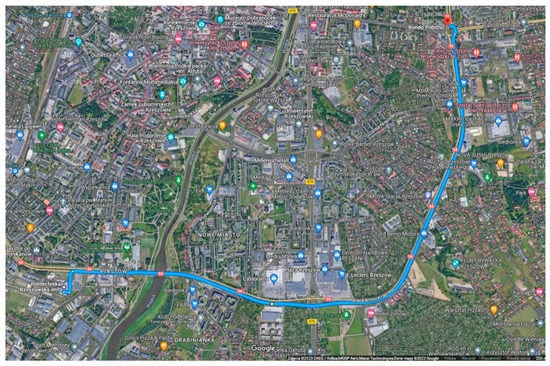
Figure 2.
The map with the marked section of the Urban Rzeszow Road Cycle (URRC).
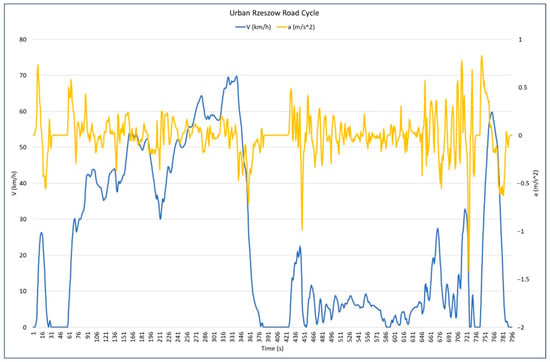
Figure 3.
Acceleration (a) and velocity (V) for Urban Rzeszow Road Cycle (URRC).
The measurement of pollutant emissions was conducted using the Horiba OBS-2200 Portable Emission Measurement System (HORIBA Advanced Techno, Co., Ltd., Kyoto, Japan), and the essential specifications of this system are presented in Table 2. The temperature during the road tests was about 12 °C. The pressure during the tests was 99.5 ± 0.5 kPa. The emissions resulting from real road tests were compared to the emissions obtained from chassis dynamometer tests conducted under controlled ambient temperature conditions within the climate chamber, with a temperature range of 12 ± 2 °C.

Table 2.
Selected technical parameters of PEMS Horiba OBS-2200.
Basic parameters of the urban test route with regard to UDC, WLTC 3b LOW, and WLTC 3b MEDIUM urban cycles are shown in Table 3.

Table 3.
Specifications of the Urban Rzeszow Road Cycle (URRC) in comparison to UDC, WLTC3b LOW, and WLTC3b MEDIUM.
In order to be able to reproduce the test conditions, Table 4 shows the parameters of the gasoline used to power the engine of the car tested. To measure parameters of gasoline, the OptiFuel—FTIR Fuel Analyzer produced by PAC (Petroleum Analyzer Company, Houston, TX, USA) company was used. In this instrument, the technique of Fourier transform infrared (FTIR) is implemented, which ensures high accuracy in identifying the chemical compounds in the fuel and their content. The measurement was carried out twice for the same gasoline sample. The results of the parameters are shown in Table 4 as the average value of the two measurements carried out.

Table 4.
Parameters of gasoline used in the study.
The values of vehicle motion resistances can be measured during coast-down tests, which are very difficult to carry out in the conditions of public roads. For this reason, such tests are carried out by car manufacturers on special roads on testing grounds. However, the values of the motion resistance function are usually not available, which makes it necessary to determine the resistance based on alternative methods. Motion resistance functions were adopted for testing according to three methods: an alternative method according to the NEDC procedure, an alternative method according to the WLTP procedure, and a calculation method. Formula (1) expresses the motion resistance function for the NEDC Alternative Road Load, which is used as an alternative method in the NEDC procedure [59]:
where:
Fp—drag force (N),
Ft—rolling resistance force (N),
A0, B0—coefficients of the resistance function in accordance with the NEDC Alternative method (the adopted values are provided in Table 5),
v—speed of vehicle (km/h).

Table 5.
Coefficients of resistance and equivalent inertia for the chassis dyno tests.
Table 5.
Coefficients of resistance and equivalent inertia for the chassis dyno tests.
| Parameter | NEDC Alternative | Road Load Calculated | WLTP Alternative |
|---|---|---|---|
| X0 or A0 (N) | 6.8 | 161.2 | 178.4 |
| X1 (N/(km/h)) | 0 | 0 | 0 |
| X2 or B0 (N/(km/h)2) | 0.046 | 0.0346 | 0.0471 |
| Equivalent inertia (kg) | 1250 | 1565 | 1274 |
The NEDC alternative method is a substitute method for road methods. The basis of this method is to take the coefficients of the traffic resistance function (A0 and B0) from a table, based on the reference mass of the vehicle RW (the car’s kerb mass + 100 kg). This table is contained in UNECE Regulation 83 and the values in it for the tested vehicle (A0, B0, equivalent inertia) are given in Table 5. For the traffic resistance functions according to the alternative NEDC and WLTP methods, the values of the car’s masses assumed during the car’s approval were assumed.
The coefficient values for the WLTP Alternative Road Load, which is an alternative method for calculating the default road load based on vehicle parameters in the WLTP procedure, were calculated as per [60]. According to this procedure, the road load function can be determined using Formula (2):
where:
H—vehicle height (m),
mt—test mass (kg),
W—vehicle width (m).
The test mass value (mt) was obtained by adding the actual vehicle mass, a representative mass for the vehicle load, and a constant mass of 25 kg, as described in Equation (3) [31]:
where:
mro—mass in running order (kg),
mvl—maximum vehicle load (kg),
ml—technically permissible maximum laden mass (kg),
mo—optional equipment mass (kg),
φ—the percentage of the vehicle load incorporated in the determination of the test mass, which is set at 15% for M1 category vehicles (passenger cars).
In the Road Load Calculated method, the values of traffic resistance corresponding to travel speed were derived using Equation (4) as stated in [61]:
where:
fo—rolling resistance coefficient for low travel speeds (fo = 0.0105),
m—weight of the vehicle (kg),
A—frontal area of the vehicle, (m2),
g—acceleration due to gravity, (m/s2),
cx—aerodynamic drag coefficient in the longitudinal direction,
v—speed (km/h).
Conducting road tests to determine drag function coefficients is not feasible under the requirements of the type-approval regulations, under public road conditions, and would require testing on a training ground or airport runway. Therefore, the value of the coefficient of rolling resistance (fo) was determined on the basis of road tests, for coast-down tests from an initial speed of 10 km/h. These tests were carried out using the DLS-2 optoelectronic sensor measurement system from DATRON.
Apart from the Fo force, there is an additional inertia drag force that occurs during acceleration and is dependent on the car’s mass and the magnitude of positive acceleration. Typically, the inertia drag force is computed using Formula (5):
where:
a—acceleration, (m/s2),
δ—rotating mass factor (δ = 1.03).
Equation (6) defines the total force of vehicle motion resistance, Fc, when driving on a horizontal road:
where:
Fb—inertia drag force (N),
Ft—rolling resistance force (N),
Fp—drag force (N).
The values of the motion resistance functions adopted for the chassis dynamometer tests are summarized in Table 5. Figure 4 shows a comparison of the total motion drag force Fc as a function of time, for the URRC test cycle. This function shows the summed rolling, air, and inertia resistances for the three methods analyzed.
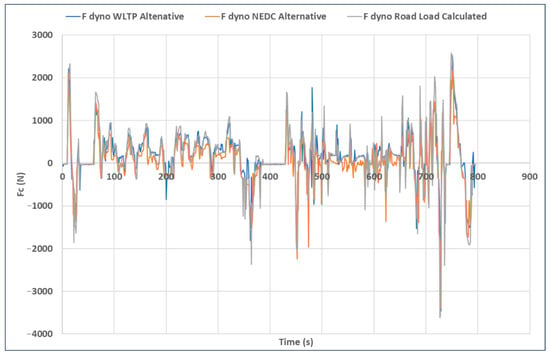
Figure 4.
Total vehicle motion resistance force for analyzed methods.
3. Results and Discussion
Chassis dynamometer tests were conducted for the urban Rzeszow road cycle, for three traffic resistance functions: according to NEDC Alternative Road Load, WLTP Alternative Road Load, and Road Load Calculated. The results of laboratory tests of CO2, CO, NOx, THC emissions, and fuel (energy) consumption for the analyzed traffic resistance functions in comparison with the results obtained in road tests are illustrated in Figure 5, Figure 6, Figure 7, Figure 8, Figure 9, Figure 10, Figure 11, Figure 12, Figure 13, Figure 14 and Figure 15. The measurement uncertainty values were determined according to the methodology in [62] and are shown in Figure 5, Figure 6, Figure 8, Figure 10 and Figure 12 as error bars.
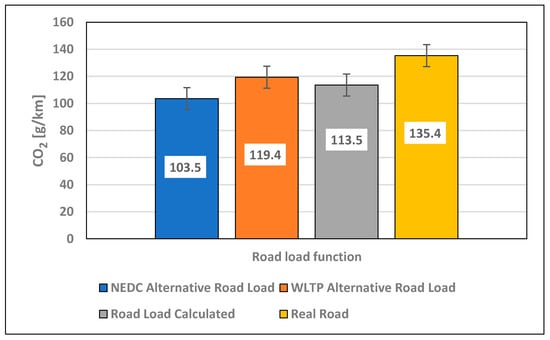
Figure 5.
Comparison of average CO2 emission factor in the URRC cycle obtained in road tests and chassis dynamometer tests for analyzed road load functions.
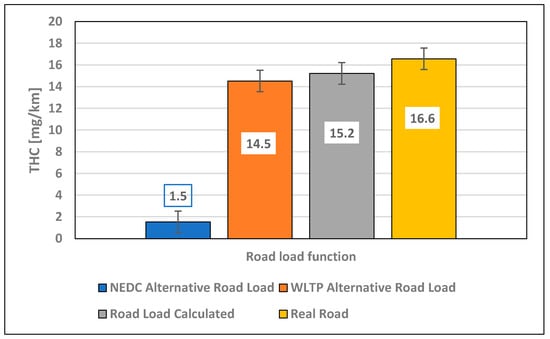
Figure 6.
Comparison of average THC emission factor in the URRC cycle obtained in road and chassis dynamometer tests for analyzed road load functions.
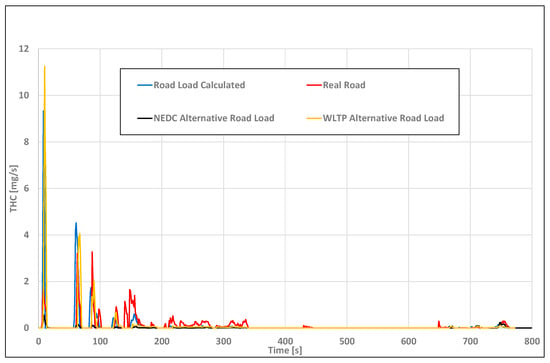
Figure 7.
Instantaneous emissions of THC.
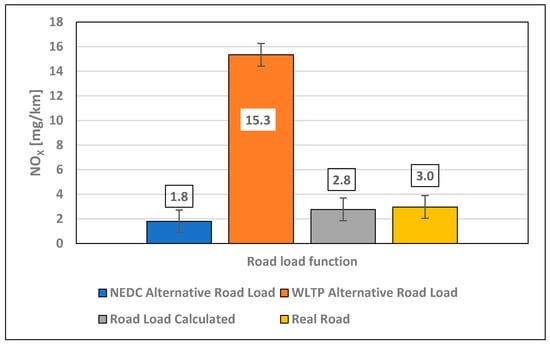
Figure 8.
Comparison of average NOx emission factor in the URRC cycle obtained in road and chassis dynamometer tests for analyzed road load functions.
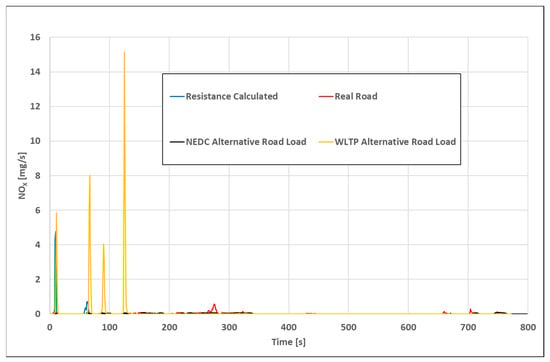
Figure 9.
Instantaneous emissions of NOx.
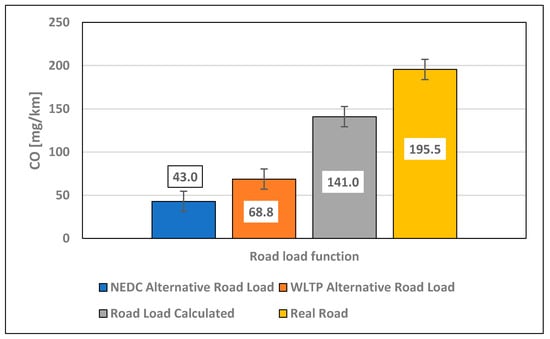
Figure 10.
Comparison of average CO emission factor in the URRC cycle obtained in road and chassis dynamometer tests for analyzed road load functions.
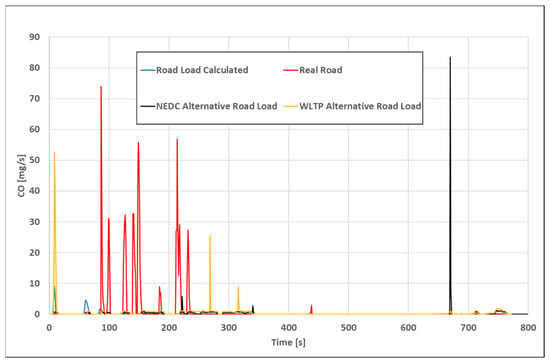
Figure 11.
Instantaneous emissions of CO.
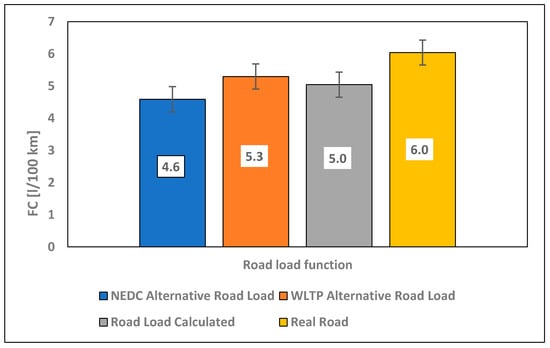
Figure 12.
Comparison of the average fuel consumption in the URRC cycle obtained in road and chassis dynamometer tests for the analyzed road load functions.
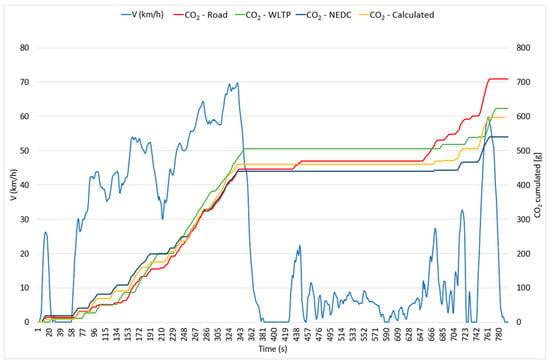
Figure 13.
Cumulative CO2 emissions for the tests according to the adopted traffic resistance functions in relation to the emissions obtained during the road test.
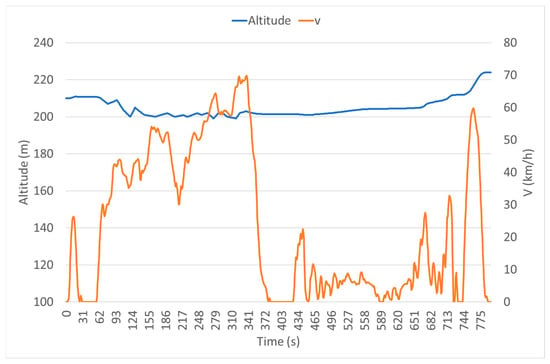
Figure 14.
Altitude changes for the studied road section in the URRC cycle.
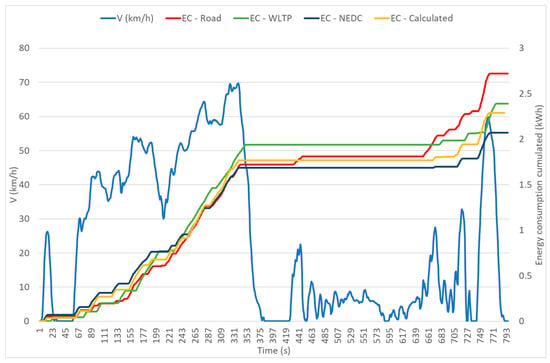
Figure 15.
Cumulative energy consumption for tests according to adopted traffic resistance functions in relation to energy consumption during road tests.
The car’s chassis dynamometer test results in terms of CO2 emissions (Figure 5) under the NEDC alternative procedure were the lowest, reaching a value of approx. 103 g/km, compared to approx. 119 g/km under the WLTP alternative procedure and approx. 113 g/km road load calculated, while the highest CO2 emission value of approx. 135 g/km was obtained under real road conditions (Real Road).
The lowest THC emission value of about 1.5 mg/km (Figure 6) was obtained according to the NEDC Alternative methodology, while significantly higher values were obtained for the other traffic resistance functions, which amounted to about 14.6 mg/km according to the WLTP Alternative methodology and Road Load Calculated about 15.2 mg/km. For the Real Road cycle, the average emissions were about 16.5 mg/km. The lower THC emissions for tests performed with a drag function according to the alternative NEDC method can be related to the significantly lower traffic resistance, which was associated with the greater driving range of the car in EV mode. As for driving with propulsion transferred from the internal combustion engine, the lower traffic resistance was also related to lower engine loads and reduced enriched mixture phases.
It can be seen that under dynamic conditions, the instantaneous THC emission (Figure 7) is not directly dependent only on the driving speed and the value of the load on the wheels of the car. In fact, it is the result of many factors included in the control algorithm of the hybrid car’s powertrain. It is necessary to take into account changes in the composition of the mixture, the efficiency of the catalytic reactor, but also the instantaneous energy demand, which depends on the resistance to motion. Determining which of the many factors had a decisive influence on the value of instantaneous THC emissions, under the conditions of this type of test, is not possible. The above relationships are also adequate for the instantaneous emissions of NOx (Figure 9) and CO (Figure 11).
In the case of NOx emissions, the highest value of about 15 mg/km (Figure 8) was obtained for the drag function adopted according to the WLTP Alternative methodology. For the other cases, the value of the average emission factor was much lower, amounting to about 2 mg/km for NEDC Alternative and about 3 mg/km for Road Load Calculated. For the Real Road cycle, the value of the average NOx emission index was about 3 mg/km. Increased NOx emissions may be due to the control strategy of the hybrid drive, whose operating parameters take into account the pursuit of maximum efficiency of the internal combustion engine. Instantaneous NOx emissions (Figure 9) for a function of traffic resistance were the highest. As with THC emissions, there was no direct relationship between the instantaneous emission value and driving speed and wheel load. As with THC emissions, the instantaneous NOx emission value is also influenced by many other factors.
A large discrepancy in test results was noted for CO emissions (Figure 10). For the traffic resistance function according to the NEDC Alternative methodology, CO emissions were the lowest, reaching a value of about 43 mg/km; according to the WLTP Alternative methodology, the value was about 69 mg/km, and according to the Road Load Calculated methodology, it was about 141 mg/km. The highest CO value of about 195 mg/km was obtained under Real Road conditions. CO emissions are highly dependent on the internal combustion engine load, which depends on the motion resistance function. For the cycle analyzed, the traffic resistance functions determined the engine load to varying degrees. The lowest load with respect to the entire cycle occurred for the NEDC alternative function. This was followed by WLTP Alternative and Road Load Calculated engine loads. The highest loads accompanied driving in the actual road cycle. Instantaneous CO values (Figure 11) are not only dependent on the traffic resistance function, but, as with THC and NOx, are the resultant of many factors. This is evidenced by the sharp increase in instantaneous CO emissions for the NEDC Alternative’s traffic resistance function at around 670 s of the cycle. The fact that CO emissions are not solely dependent on the load on the car’s wheels, unlike CO2 emissions, is evidenced by the results shown in Figure 5. For the Road Load Calculated traffic resistance function, CO2 emissions values were lower than for the WLTP Alternative Road Load function, while the opposite relationship was obtained for CO emissions. CO2 emissions are related to fuel consumption, while CO emissions are determined by imperfections in the combustion process.
Figure 12 shows a comparison of mileage fuel consumption determined by carbon balance. As in the case of CO2 emissions, the lowest fuel consumption value of about 4.6 L/100 km was obtained for tests carried out for the traffic resistance function determined according to the NEDC Alternative. The highest fuel consumption of about 6 L/100 km, was obtained for tests under Real Road conditions. In other cases, i.e., for the resistance function according to the WLTP Alternative and Road Load Calculated, similar fuel consumption was obtained at about 5.3 L/100 km and 5 L/100 km, respectively. Reduced fuel consumption for the resistance function according to the alternative NEDC method is associated with lower values of the drag forces, and thus reduced energy demand at the drive wheels. This resulted in the hybrid drive operating in the lower load range, which was associated with lower fuel consumption. It also resulted in lower emission values of the analyzed pollutants in the exhaust gas for this motion resistance function.
Proportional to fuel consumption are energy consumption values. The values of the energy consumption were calculated by Equation (7):
where:
EC—energy consumption (kWh/100 km),
ρf—fuel density (kg/L),
LHV—lower heating value of petrol (kJ/kg).
Similar results were obtained in studies by other authors [31], who compared the results of road tests with those according to NEDC and WLTC cycles [31,33,34]. The WLTC cycle provides results more similar to those obtained on the road.
Figure 13 shows the changes in CO2 cumulative emission values as a function of cycle time. It can be seen that the CO2 emission values are not proportional to the adopted traffic resistance functions in each cycle period. In the initial period, the highest CO2 emission values occurred for the traffic resistance function according to the NEDC Alternative method. This may be related to differences in the values of the total traffic resistance function, which also takes into account inertia resistance, which depends on instantaneous accelerations. The cycle was implemented on the dynamometer bench by the same driver, who maintained the speed values according to the assumed driving cycle within a tolerance of ±2 km/h. In the case of a cycle realized in road conditions, the road gradient and the associated uphill drag forces are also important. Altitude changes for the cycle realized in road conditions (Figure 14) show some consistency with changes in CO2 emissions (Figure 13), which was initially lowest in the time range up to about 280 s. Up to this time value, the car traveled on the road with a downward slope, while in the later part of the cycle (from about 315 s onward) the slope of the road was positive. Moreover, in the case of the full-hybrid car under study, the initial values of the battery’s state of charge also influenced the starting of the internal combustion engine and the associated emissions in the exhaust gas. In the case of the full hybrid car under test, battery charging is realized exclusively through the internal combustion engine (it was not a plug-in vehicle). Therefore, prior to testing, engine and drivetrain warm-up was implemented with a high proportion of braking phases, so as to achieve a battery charge level corresponding to full capacity. In other publications dedicated to analyzing the energy consumption of hybrid cars, the energy consumption value is also based on the energy contained in the fuel consumed by the internal combustion engine [63,64].
Figure 15 shows a comparison of cumulative energy consumption for tests according to adopted traffic resistance functions in relation to energy consumption in road tests. Similarly to CO2 emissions, changes in energy consumption disproportionate to the values of the adopted traffic resistance functions can be seen in each cycle range. The highest increases in energy consumption initially occurred for resistance according to the NEDC Alternative method, while they occurred in the final phase of the cycle for Real Road, in line with the increased resistance associated with the increase in the slope of the road (Altitude).
An additional parameter that also affects the differences in the results of vehicle emissions and energy consumption is the mass of the car. For the motion resistance functions according to the alternative NEDC and WLTP methods, the values of the car’s mass adopted during the car’s approval were used. These values often deviate from the car’s weight in actual traffic. In the case analyzed, the differences in masses for tests according to the alternative NEDC and WLTP methods, in relation to the actual mass, were lower by about 20%. Associated with the mass of the vehicle are the values of rolling resistance forces, inertia force and road slope resistance.
4. Conclusions
When carrying out tests on a chassis dynamometer, it is necessary to determine the resistance functions, which are intended to reflect the resistance acting on the car in real traffic conditions on the road. The values of vehicle motion resistance can be measured during coast-down tests. Such tests are carried out by car manufacturers on special roads on testing grounds. However, the values of the motion resistance functions are usually unavailable, which makes it necessary to determine the resistance based on alternative methods. The primary purpose of this article was to compare the effects of traffic resistance functions determined by alternative methods, on emissions and energy consumption of a hybrid car, in an example urban driving cycle. The article presents a comparison of test results of gaseous pollutant emissions and energy consumption for a hybrid car under laboratory and road conditions. The tests were carried out according to the urban real road cycle URRC determined in Rzeszow. The research confirms that, in addition to the driving cycle, the values of traffic resistance adopted for braking tests in relation to the resistance acting on the car in real road conditions are very important.
The paper shows that results of emissions and fuel consumption tests obtained on a chassis dynamometer may not accurately reflect real-world driving conditions. As the research has shown, the resistance to motion has a major impact on the results of measuring pollutants in the exhaust gas and fuel consumption (energy) for the cycle under study. Despite the adopted resistance function based on road coasting tests (Resistance Calculated), the emission values of the tested pollutants differed significantly from those obtained in road tests. For the road tests, the emissions values, relative to the dynamometer tests for the Road Load Calculated resistance function, were higher by about 19% for CO2, about 8% for THC, about 38% for CO, and about 7% for NOx, respectively. Fuel consumption in the road tests was about 20% higher than in the laboratory test for the Road Load Calculated resistance function. This indicates that when driving under road conditions, there are additional traffic resistances related to, among other things, road gradient, wind resistance, and other factors that cannot be fully taken into account in chassis dynamometer tests. Therefore, in order to obtain results on a chassis dynamometer that more closely resemble reality, it is particularly important to introduce additional motion resistance forces associated with the change in altitude on a chassis dynamometer.
Among the considered motion resistance functions, the results closest to the values obtained from road tests for the analyzed driving cycle, concerning CO2 emissions and fuel (energy) consumption, were observed with the function based on the WLTP Alternative method. However, the function adopted following the NEDC Alternative procedure yielded the lowest values for both CO2 emissions and energy consumption. Thus, the adoption of the drag function according to the new WLTP Alternative approval procedure is favorable.
The creation of such urban driving cycles, which take into account the traffic resistance associated with road resistance, could be also useful, for example, for city buses that travel in the city area along designated routes.
Adequate for the adopted scope of work, the article presents a method of conducting tests under the conditions of a chassis dynamometer for a real driving cycle. However, traffic resistance functions were taken into account according to alternative methods for car type approval tests. The tests were carried out considering an exemplary but real cycle of one vehicle. However, generalizing the results is related to the need to take into account a larger number of vehicles and different real driving cycles in the tests. This will be the subject of future work.
The major findings of the study are:
- comparison of road and chassis dynamometer test results for the road driving cycle,
- identification of the differences between test results for the adopted motion resistance functions,
- confirmation that in chassis dynamometer tests, for the same driving cycle, the WLTP alternative method’s drag function gives the most similar CO2 emissions and fuel consumption results relative to values obtained in road tests, and can be used in the absence of manufacturer information of the resistance function,
- identification of the factors influencing the differences between road and laboratory test results.
Author Contributions
Conceptualization, A.J. and K.L.; methodology, A.J. and H.K.; software, K.B. and P.W. (Paweł Wojewoda); validation, A.J., H.K., R.L. and K.L.; formal analysis, A.J., H.K., P.W. (Paweł Woś), R.L. and S.B.; investigation, A.J., H.K., P.W. (Paweł Wojewoda) and K.L.; resources, A.J., K.B., P.W. (Paweł Woś) and P.W. (Paweł Wojewoda); data curation, A.J., K.B. and H.K.; writing—original draft preparation, A.J., K.B., P.W. (Paweł Wojewoda), P.W. (Paweł Woś), K.L, R.L. and H.K.; writing—review and editing, A.J., K.B., H.K., P.W. (Paweł Woś), R.L., S.B. and K.L.; visualization, A.J., K.B., and P.W. (Paweł Wojewoda); supervision, A.J. and P.W. (Paweł Woś). All authors have read and agreed to the published version of the manuscript.
Funding
The authors wish to acknowledge the Polish Ministry of Education and Science and the Rzeszow University of Technology for supporting this research.
Conflicts of Interest
The authors declare no conflict of interest.
Abbreviations
| AVL | Anstalt für Verbrennungskraftmaschinen List |
| CLD | Chemiluminescence Detector |
| CO | Carbon monoxide |
| CO2 | Carbon dioxide |
| EC | Energy consumption |
| FC | Fuel consumption |
| FID | Flame Ionization Detector |
| FTP | Federal Test Procedure |
| FTIR | Fourier transform infrared |
| LHV | Lower heating value |
| NEDC | New European Driving Cycle |
| NOx | Nitrogen oxides |
| PEMS | Portable Emissions Measurement Systems |
| PHEV | Plug-in hybrid electric vehicle |
| RDE | Real driving emissions |
| SOC | State of charge |
| THC | Total hydrocarbons |
| TWC | Three-way catalytic converter |
| UDC | Urban Driving Cycle |
| URRC | Urban Rzeszow Road Cycle |
| WLTP | Worldwide Harmonized Light Vehicle Test Procedure |
| WLTC | World-wide harmonized Light duty Test Cycle |
References
- Skobiej, K.; Pielecha, J. Analysis of the Exhaust Emissions of Hybrid Vehicles for the Current and Future RDE Driving Cycle. Energies 2022, 15, 8691. [Google Scholar] [CrossRef]
- Skobiej, K.; Pielecha, J. Plug-in Hybrid Ecological Category in Real Driving Emissions. Energies 2021, 14, 2340. [Google Scholar] [CrossRef]
- Mądziel, M.; Campisi, T.; Jaworski, A.; Tesoriere, G. The Development of Strategies to Reduce Exhaust Emissions from Passenger Cars in Rzeszow City-Poland A Preliminary Assessment of the Results Produced by the Increase of E-Fleet. Energies 2021, 14, 1046. [Google Scholar] [CrossRef]
- Ma, C.; Madaniyazi, L.; Xie, Y. Impact of the Electric Vehicle Policies on Environment and Health in the Beijing-Tianjin-Hebei Region. Int. J. Environ. Res. Public Health 2021, 18, 623. [Google Scholar] [CrossRef] [PubMed]
- Gai, Y.; Minet, L.; Posen, I.D.; Smargiassi, A.; Tétreault, L.F.; Hatzopoulou, M. Health and climate benefits of electric vehicle deployment in the greater Toronto and Hamilton area. Environ. Pollut. 2020, 265, 114983. [Google Scholar] [CrossRef] [PubMed]
- Zare, A.; Stevanovic, S.; Jafari, M.; Verma, P.; Babaie, M.; Yang, L.; Rahman, M.M.; Ristovski, Z.D.; Brown, R.J.; Bodisco, T.A. Analysis of cold-start NO2 and NOx emissions, and the NO2/NOx ratio in a diesel engine powered with different diesel-biodiesel blends. Environ. Pollut. 2021, 290, 118052. [Google Scholar] [CrossRef]
- Liang, Z.; Yu, Z.; Liu, H.; Chen, L.; Huang, X. Combustion and emission characteristics of a compression ignition engine burning a wide range of conventional hydrocarbon and alternative fuels. Energy 2022, 250, 123717. [Google Scholar] [CrossRef]
- Liang, Z.; Salehi, F.; Yu, Z.; Wang, C.; Chen, L. Characterizing the gaseous and particulate SVOC emissions of a commercial light-duty compression ignition engine via GCxGC-ToF-MS. Fuel 2021, 284, 118918. [Google Scholar] [CrossRef]
- Chen, L.; Liang, Z.; Liu, H.; Ding, S.; Li, Y. Sensitivity analysis of fuel types and operational parameters on the particulate matter emissions from an aviation piston engine burning heavy fuels. Fuel 2017, 202, 520–528. [Google Scholar] [CrossRef]
- Pielecha, J.; Skobiej, K.; Kubiak, P.; Wozniak, M.; Siczek, K. Exhaust Emissions from Plug-in and HEV Vehicles in Type-Approval Tests and Real Driving Cycles. Energies 2022, 15, 2423. [Google Scholar] [CrossRef]
- Mądziel, M.; Jaworski, A.; Kuszewski, H.; Woś, P.; Campisi, T.; Lew, K. The Development of CO2 Instantaneous Emission Model of Full Hybrid Vehicle with the Use of Machine Learning Techniques. Energies 2022, 15, 142. [Google Scholar] [CrossRef]
- Lijewski, P.; Ziolkowski, A.; Daszkiewicz, P.; Andrzejewski, M.; Gallas, D. Comparison of CO2 emissions and fuel consumption of a hybrid vehicle and a vehicle with a direct gasoline injection engine. IOP Conf. Ser. Mater. Sci. Eng. 2018, 421, 042046. [Google Scholar] [CrossRef]
- Lorf, C.; Martinez-Botas, R.; Howey, D.; Lytton, L.; Cussons, B. Comparative analysis of the energy consumption and CO2 emissions of 40 electric, plug-in hybrid electric, hybrid electric and internal combustion engine vehicles. Transp. Res. 2013, 23, 12–19. [Google Scholar] [CrossRef]
- Ahn, K.; Park, S.; Rakha, H.A. Impact of Intersection Control on Battery Electric Vehicle Energy Consumption. Energies 2020, 13, 3190. [Google Scholar] [CrossRef]
- Merl, R.; Jung, C.; Huss, A.; Klumaier, K. Innovative Solutions for the Calibration of Hybrid Drives. ATZ Worldw. 2020, 122, 38–43. [Google Scholar] [CrossRef]
- Lü, X.; Wu, Y.; Lian, J.; Zhang, Y.; Chen, C.; Wang, P.; Meng, L. Energy management of hybrid electric vehicles: A review of energy optimization of fuel cell hybrid power system based on genetic algorithm. Energy Conv. Manag. 2020, 205, 112474. [Google Scholar] [CrossRef]
- Orecchini, F.; Santiangeli, A.; Zuccari, F.; Alessandrini, A.; Cignini, F.; Ortenzi, F. Real Drive Truth Test of the Toyota Yaris Hybrid 2020 and Energy Analysis Comparison with the 2017 Model. Energies 2021, 14, 8032. [Google Scholar] [CrossRef]
- Szałek, A.; Pielecha, I. The Influence of Engine Downsizing in Hybrid Powertrains on the Energy Flow Indicators under Actual Traffic Conditions. Energies 2021, 14, 2872. [Google Scholar] [CrossRef]
- Orecchini, F.; Santiangeli, A.; Zuccari, F.; Ortenzi, F.; Genovese, A.; Spazzafumo, G.; Nardone, L. Energy consumption of a last generation full hybrid vehicle compared with a conventional vehicle in real drive conditions. Energy Procedia 2018, 148, 289–296. [Google Scholar] [CrossRef]
- Pielecha, I.; Cieslik, W.; Szwajca, F. Energy Flow and Electric Drive Mode Efficiency Evaluation of Different Generations of Hybrid Vehicles under Diversified Urban Traffic Conditions. Energies 2023, 16, 794. [Google Scholar] [CrossRef]
- Fontaras, G.; Zacharof, N.-G.; Ciuffo, B. Fuel consumption and CO2 emissions from passenger cars in Europe—Laboratory versus real-world emissions. Prog. Energy Combust. Sci. 2017, 60, 97–131. [Google Scholar] [CrossRef]
- Merkisz, J.; Pielecha, J.; Bielaczyc, P.; Woodburn, J.; Szalek, A. A Comparison of Tailpipe Gaseous Emissions from the RDE and WLTP Test Procedures on a Hybrid Passenger Car; SAE Technical Paper No. 2020-01-2217; SAE: Warrendale, PA, USA, 2020. [Google Scholar] [CrossRef]
- Riemersma, I.; Mock, P. Too Low to be True? How to Measure Fuel Consumption and CO2 Emissions of Plug-In Hybrid Vehicles, Today and in the Future. The International Council on Clean Transportation. 2017. Available online: https://theicct.org/sites/default/files/publications/EU-PHEV_ICCT-Briefing-Paper_280717_vF.pdf (accessed on 21 November 2021).
- García-Contreras, R.; Soriano, J.A.; Fernández-Yáñez, P.; Sánchez-Rodríguez, L.; Mata, C.; Gómez, A.; Armas, O.; Cárdenas, M.D. Impact of regulated pollutant emissions of Euro 6d-Temp light-duty diesel vehicles under real driving conditions. J. Clean. Prod. 2021, 286, 124927. [Google Scholar] [CrossRef]
- Triantafyllopoulos, G.; Katsaounis, D.; Karamitros, D.; Ntziachristos, L.; Samaras, Z. Experimental assessment of the potential to decrease diesel NOx emissions beyond minimum requirements for Euro 6 Real Drive Emissions (RDE) compliance. Sci. Total Environ. 2018, 618, 1400–1407. [Google Scholar] [CrossRef] [PubMed]
- Tansini, A.; Pavlovic, J.; Fontaras, G. Quantifying the real-world CO2 emissions and energy consumption of modern plug-in hybrid vehicles. J. Clean. Prod. 2022, 362, 132191. [Google Scholar] [CrossRef]
- Pavlovic, J.; Fontaras, G.; Ktistakis, M.; Anagnostopoulos, K.; Komnos, D.; Ciuffo, B.; Clairotte, M.; Valverde, V. Understanding the origins and variability of the fuel consumption gap: Lessons learned from laboratory tests and a real-driving campaign. Environ. Sci. Eur. 2020, 32, 53. [Google Scholar] [CrossRef]
- Lejda, K.; Jaworski, A.; Mądziel, M.; Balawender, K.; Ustrzycki, A.; Savostin-Kosiak, D. Assessment of Petrol and Natural Gas Vehicle Carbon Oxides Emissions in the Laboratory and On-Road Tests. Energies 2021, 14, 1631. [Google Scholar] [CrossRef]
- Tietge, U.; Zacharof, N.; Mock, P.; Franco, V.; German, J.; Bandivadekar, A.; Ligterink, N.; Lambrecht, U. From laboratory to road—A 2015 update of official and “real-world” fuel consumption and CO2 values for passenger cars in Europe. Int. Counc. Clean Transp. 2015, 49, 847129-102. [Google Scholar]
- Kadijk, G.; Verbeek, R.; Smokers, R.; Spreen, J.; Patuleia, A.; Van Ras, M. Supporting Analysis Regarding Test Procedure Flexibilities and Technology Deployment for Review of the Light Duty Vehicle CO2 Regulations; European Commission: Brussel, Belgium, 2012. [Google Scholar] [CrossRef]
- Fontaras, G.; Ciuffo, B.; Zacharof, N.; Tsiakmakis, S.; Marotta, A.; Pavlovic, J.; Anagnostopoulos, K. The difference between reported and real-world CO2 emissions: How much improvement can be expected by WLTP introduction? Transp. Res. Procedia 2017, 25, 3933–3943. [Google Scholar] [CrossRef]
- Pavlovic, J.; Marotta, A.; Ciuffo, B. CO2 emissions and energy demands of vehicles tested under the NEDC and the new WLTP type approval test procedures. Appl. Energy 2016, 177, 661–670. [Google Scholar] [CrossRef]
- Tsiakmakis, S.; Fontaras, G.; Cubito, C.; Pavlovic, J.; Anagnostopoulos, K.; Ciuffo, B. From NEDC to WLTP: Effect on the Type-Approval CO2 Emissions of Light-Duty Vehicles; Publications Office of the European Union: Brussels, Belgium, 2017; p. 50. [Google Scholar]
- Liu, X.; Zhao, F.; Hao, H.; Chen, K.; Liu, Z.; Babiker, H.; Amer, A.A. From NEDC to WLTP: Effect on the Energy Consumption, NEV Credits, and Subsidies Policies of PHEV in the Chinese Market. Sustainability 2020, 12, 5747. [Google Scholar] [CrossRef]
- Jaworski, A.; Mądziel, M.; Lew, K.; Campisi, T.; Woś, P.; Kuszewski, H.; Wojewoda, P.; Ustrzycki, A.; Balawender, K.; Jakubowski, M. Evaluation of the Effect of Chassis Dynamometer Load Setting on CO2 Emissions and Energy Demand of a Full Hybrid Vehicle. Energies 2022, 15, 122. [Google Scholar] [CrossRef]
- Jaworski, A.; Mądziel, M.; Kuszewski, H.; Lejda, K.; Balawender, K.; Jaremcio, M.; Jakubowski, M.; Woś, P.; Lew, K. The Impact of Driving Resistances on the Emission of Exhaust Pollutants from Vehicles with the Spark Ignition Engine Fuelled by Petrol and LPG; SAE Technical Paper No. 2020-01-2206; SAE: Warrendale, PA, USA, 2020. [Google Scholar] [CrossRef]
- Kadijk, G.; Ligterink, N. Road Load Determination of Passenger Cars. Available online: https://www.tno.nl/media/1971/road_load_determination_passenger_cars_tno_r10237.pdf (accessed on 3 April 2019).
- Kühlwein, J. The Impact of Official Versus Real-World Road Loads on CO2 Emissions and Fuel Consumption of European Passenger Cars. The International Council on a Clean Transportation. White Paper. 2016. Available online: https://www.theicct.org/sites/default/files/publications/ICCT_Coastdowns-EU_201605.pdf (accessed on 12 April 2019).
- Jaworski, A.; Mądziel, M.; Lejda, K. Creating an emission model based on portable emission measurement system for the purpose of a roundabout. Environ. Sci. Pollut. Res. 2019, 26, 21641. [Google Scholar] [CrossRef] [PubMed]
- Mądziel, M.; Campisi, T.; Jaworski, A.; Kuszewski, H.; Woś, P. Assessing Vehicle Emissions from a Multi-Lane to Turbo Roundabout Conversion Using a Microsimulation Tool. Energies 2021, 14, 4399. [Google Scholar] [CrossRef]
- Szumska, E.M.; Jurecki, R. The Analysis of Energy Recovered during the Braking of an Electric Vehicle in Different Driving Conditions. Energies 2022, 15, 9369. [Google Scholar] [CrossRef]
- Szumska, E.M.; Jurecki, R. The Effect of Aggressive Driving on Vehicle Parameters. Energies 2020, 13, 6675. [Google Scholar] [CrossRef]
- Kurtyka, K.; Pielecha, J. The evaluation of exhaust emission in RDE tests including dynamic driving conditions. Transport. Res. Proc. 2019, 40, 338e345. [Google Scholar] [CrossRef]
- Pielecha, J.; Skobiej, K.; Kurtyka, K. Exhaust Emissions and Energy Consumption Analysis of Conventional, Hybrid, and Electric Vehicles in Real Driving Cycles. Energies 2020, 13, 6423. [Google Scholar] [CrossRef]
- Mock, P.; German, J.; Bandivadekar, A.; Riemersma, I. Discrepancies between Type-Approval and “Real-World” Fuel-Consumption and CO2 Values in 2001–2011 European Passenger Cars. ICCT, International Council on Clean Transportation. 2012. Available online: https://theicct.org/wp-content/uploads/2021/06/ICCT_EU_fuelconsumption2_workingpaper_2012.pdf (accessed on 10 December 2022).
- Ivanov, Y.; Ivanov, R.; Kadikyanov, G.; Staneva, G.; Danilov, I. A study of the fuel consumption of hybrid car Toyota Yaris. Transport Problems. Transp. Probl. 2019, 14, 155–167. [Google Scholar] [CrossRef]
- Jaworski, A.; Kuszewski, H.; Ustrzycki, A.; Balawender, K. Analysis of the repeatability of exhaust pollutans emission research for cold and hot starts under controlled driving cycle conditions. Environ. Sci. Pollut. Res. 2018, 25, 17862–17877. [Google Scholar] [CrossRef]
- Jaworski, A.; Mądziel, M.; Kuszewski, H.; Lejda, K.; Balawender, K.; Jaremcio, M.; Jakubowski, M.; Wojewoda, P.; Lew, K.; Ustrzycki, A. Analysis of Cold Start Emission from Light Duty Vehicles Fueled with Gasoline and LPG for Selected Ambient Temperatures; SAE Technical Paper No. 2020-01-2207; SAE: Warrendale, PA, USA, 2020. [Google Scholar] [CrossRef]
- Melas, A.; Selleri, T.; Franzetti, J.; Ferrarese, C.; Suarez-Bertoa, R.; Giechaskiel, B. On-Road and Laboratory Emissions from Three Gasoline Plug-In Hybrid Vehicles-Part 2: Solid Particle Number Emissions. Energies 2022, 15, 5266. [Google Scholar] [CrossRef]
- Wang, Y.; Wen, Y.; Zhu, Q.; Luo, J.; Yang, Z.; Su, S.; Wang, X.; Hao, L.; Tan, J.; Yin, H.; et al. Real driving energy consumption and CO2 & pollutant emission characteristics of a parallel plug-in hybrid electric vehicle under different propulsion modes. Energy 2022, 244, 123076. [Google Scholar] [CrossRef]
- Šmigins, R.; Pīrs, V.; Berjoza, D. Investigation in fuel consumption of a hybrid and conventional vehicle. Agron. Res. 2020, 18, 1027–1035. [Google Scholar] [CrossRef]
- Mamala, J.; Graba, M.; Bieniek, A.; Prażnowski, K.; Augustynowicz, A.; Śmieja, M. Study of energy consumption of a hybrid vehicle in real-world conditions. Eksploat. I Niezawodn. Maint. Reliab. 2021, 23, 636–645. [Google Scholar] [CrossRef]
- Orecchini, F.; Santiangeli, A.; Zuccari, F. Real Drive Well-to-Wheel Energy Analysis of Conventional and Electrified Car Powertrains. Energies 2020, 13, 4788. [Google Scholar] [CrossRef]
- Plötz, P.; Link, S.; Ringelschwendner, H.; Keller, M.; Moll, C.; Bieker, G.; Dornoff, J.; Mock, P. Real-World Usage of Plug-In Hybrid Vehicles in Europe: A 2022 Update on Fuel Consumption, Electric Driving, and CO2 Emissions. Available online: https://theicct.org/wp-content/uploads/2022/06/real-world-phev-use-jun22.pdf (accessed on 8 June 2022).
- Bieniek, A.; Graba, M.; Mamala, J.; Prażnowski, K.; Hennek, K. Energy consumption of a passenger car with a hybrid powertrain in real traffic conditions. Combust. Engines 2022, 191, 15–22. [Google Scholar] [CrossRef]
- Ferreira, H.; Rodrigues, C.M.; Pinho, C. Impact of Road Geometry on Vehicle Energy Consumption and CO2 Emissions: An Energy-Efficiency Rating Methodology. Energies 2020, 13, 119. [Google Scholar] [CrossRef]
- Degeilh, P.; Prevost, V.; Kermani, J.; Dauphin, R. Evaluation of Plug-In Hybrid Vehicles in Real-World Conditions. Concawe Report No. 10/22. Available online: https://www.concawe.eu/wp-content/uploads/Rpt-10-22.pdf (accessed on 12 March 2023).
- Colin, G.; Chamaillard, Y.; Charlet, A.; Nelson-Gruel, D. Towards a Friendly Energy Management Strategy for Hybrid Electric Vehicles with Respect to Pollution, Battery and Drivability. Energies 2014, 7, 6013–6030. [Google Scholar] [CrossRef]
- Regulation No 83 of the Economic Commission for Europe of the United Nations (UN/ECE)—Uniform Provisions Concerning the Approval of Vehicles with Regard to the Emission of Pollutants According to Engine Fuel Requirements. Available online: https://eur-lex.europa.eu/legal-content/EN/TXT/PDF/?uri=CELEX:42012X0215(01)&from=EN (accessed on 21 May 2016).
- Commission Regulation (EU) 2017/1151. Available online: https://eur-lex.europa.eu/legal-content/EN/TXT/PDF/?uri=CELEX:32017R1151&from=PL (accessed on 2 October 2021).
- Siłka, W. Teoria Ruchu Samochodu; WNT: Warsaw, Poland, 2002. [Google Scholar]
- Giechaskiel, B.; Clairotte, M.; Valverde-Morales, V.; Bonnel, P.; Kregar, Z.; Franco, V.; Dilara, P. Framework for the assessment of PEMS (Portable Emissions Measurement Systems) uncertainty. Environ. Res. 2018, 166, 251–260. [Google Scholar] [CrossRef]
- Ziółkowski, A.; Fuć, P.; Jagielski, A.; Bednarek, M.; Konieczka, S. Comparison of the Energy Consumption and Exhaust Emissions between Hybrid and Conventional Vehicles, as Well as Electric Vehicles Fitted with a Range Extender. Energies 2023, 16, 4669. [Google Scholar] [CrossRef]
- Huang, Y.; Surawski, N.C.; Organ, B.; Zhou, J.L.; Tang, O.H.H.; Chan, E.F.C. Chan, Fuel consumption and emissions performance under real driving: Comparison between hybrid and conventional vehicles. Sci. Total Environ. 2019, 659, 275–282. [Google Scholar] [CrossRef]
Disclaimer/Publisher’s Note: The statements, opinions and data contained in all publications are solely those of the individual author(s) and contributor(s) and not of MDPI and/or the editor(s). MDPI and/or the editor(s) disclaim responsibility for any injury to people or property resulting from any ideas, methods, instructions or products referred to in the content. |
© 2023 by the authors. Licensee MDPI, Basel, Switzerland. This article is an open access article distributed under the terms and conditions of the Creative Commons Attribution (CC BY) license (https://creativecommons.org/licenses/by/4.0/).